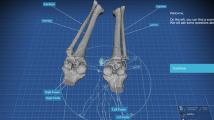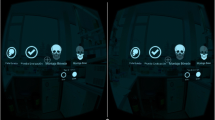Abstract
Anatomical knowledge of the larynx region is critical for understanding laryngeal disease and performing required interventions. Virtual reality is a useful method for surgical education and simulation. Here, we assembled segmented cross-section slices of the larynx region from the Chinese Visible Human dataset. The laryngeal structures were precisely segmented manually as 2D images, then reconstructed and displayed as 3D images in the virtual reality Dextrobeam system. Using visualization and interaction with the virtual reality modeling language model, a digital laryngeal anatomy instruction was constructed using HTML and JavaScript languages. The volume larynx models can thus display an arbitrary section of the model and provide a virtual dissection function. This networked teaching system of the digital laryngeal anatomy can be read remotely, displayed locally, and manipulated interactively.



Similar content being viewed by others
References
Ackerman MJ (1998) The Visible Human Project: a resource for anatomical visualization. Stud Health Technol Inform 52:1030–1032
Ackerman MJ (1999) The Visible Human Project: a resource for education. Acad Med 74:667–670
Brouwer CL, Steenbakkers RJ, van den Heuvel E, Duppen JC, Navran A, Bijl HP, Chouvalova O, Burlage FR, Meertens H, Langendijk JA, van ‘t Veld AA (2012) 3D variation in delineation of head and neck organs at risk. Radiat Oncol 7:32
Byrne AT, Walshe P, McShane D, Hamilton S (2005) Virtual laryngoscopy—preliminary experience. Eur J Radiol 56:38–42
Chen T, Chodara AM, Sprecher AJ, Fang F, Song W, Tao C, Jiang JJ (2012) A new method of reconstructing the human laryngeal architecture using micro-MRI. J Voice 26(5):555–562
Codd AM, Choudhury B (2011) Virtual reality anatomy: is it comparable with traditional methods in the teaching of human forearm musculoskeletal anatomy? Anat Sci Educ 4:119–125
Friedrich G, Lichtenegger R (1997) Surgical anatomy of the larynx. J Voice 11:345–355
Heng PA, Zhang SX, Xie YM, Wong TT, Chui YP, Cheng CY (2006) Photorealistic virtual anatomy based on Chinese Visible Human data. Clin Anat 19:232–239
Hiramatsu H, Tokashiki R, Suzuki M (2008) Usefulness of three-dimensional computed tomography of the larynx for evaluation of unilateral vocal fold paralysis before and after treatment: technique and clinical applications. Eur Arch Otorhinolaryngol 265:725–730
Hu A, Wilson T, Ladak H, Haase P, Fung K (2009) Three-dimensional educational computer model of the larynx: voicing a new direction. Arch Otolaryngol Head Neck Surg 135:677–681
Huang S, Baimouratov R, Xiao P, Ananthasubramaniam A, Nowinski WL (2006) A medical imaging and visualization toolkit in Java. J Digit Imaging 19:17–29
Jastrow H, Vollrath L (2003) Teaching and learning gross anatomy using modern electronic media based on the visible human project. Clin Anat 16:44–54
Li L, Liu YX, Song ZJ (2006) Three-dimensional reconstruction of registered and fused Chinese Visible Human and patient MRI images. Clin Anat 19:225–231
Milburn JA, Khera G, Hornby ST, Malone PS, Fitzgerald JE (2012) Introduction, availability and role of simulation in surgical education and training: review of current evidence and recommendations from the Association of Surgeons in Training. Int J Surg 10(8):393–398
Nakabayashi H, Shimizu K (2012) Stereoscopic virtual realistic surgical simulation in intracranial aneurysms. Neurol India 60:191–197
Older J (2004) Anatomy: a must for teaching the next generation. Surgeon 2:79–90
Oliker A, Napier Z, Deluccia N, Qualter J, Sculli F, Smith B, Stern C, Flores R, Hazen A, McCarthy J (2012) Step-based cognitive virtual surgery simulation: an innovative approach to surgical education. Stud Health Technol Inform 173:325–327
Serra L, Kockro R, Goh LC, Ng H, Lee EC (2002) The Dextrobeam: a stereoscopic presentation system for volumetric medical data. Stud Health Technol Inform 85:478–484
Storck C, Juergens P, Fischer C, Haenni O, Ebner F, Wolfensberger M, Sorantin E, Friedrich G, Gugatschka M (2010) Three-dimensional imaging of the larynx for pre-operative planning of laryngeal framework surgery. Eur Arch Otorhinolaryngol 267:557–563
Sugand K, Abrahams P, Khurana A (2010) The anatomy of anatomy: a review for its modernization. Anat Sci Educ 3:83–93
Wu Y, Luo N, Tan LW, Fang BJ, Li Y, Xie B, Xu HT, Hu N, Yang WP, Wu W, Lamers WH, Zhang SX (2012) Comparative study of thin sectional anatomical images from Chinese Visible Human data set and computed tomography images of superior mediastinum. Clin Anat 25:1051–1061
Zhang SX, Heng PA, Liu ZJ (2005) Chinese visible human project: dataset acquisition and its primary applications. Conf Proc IEEE Eng Med Biol Soc 4:4168–4170
Zhang SX, Heng PA, Liu ZJ (2006) Chinese visible human project. Clin Anat 19:204–215
Acknowledgments
This work was supported by a grant from the Key Program of National Natural Science Foundation of China (No. 61190122) and the Key Program of Clinical High Technology of PLA (No. 2010gxjs071).
Conflict of interest
The authors do not have any potential conflicts of interest.
Author information
Authors and Affiliations
Corresponding authors
Rights and permissions
About this article
Cite this article
Liu, K., Fang, B., Wu, Y. et al. Anatomical education and surgical simulation based on the Chinese Visible Human: a three-dimensional virtual model of the larynx region. Anat Sci Int 88, 254–258 (2013). https://doi.org/10.1007/s12565-013-0186-x
Received:
Accepted:
Published:
Issue Date:
DOI: https://doi.org/10.1007/s12565-013-0186-x




